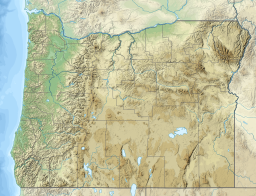
Back بحيره مالهيور ARZ Malheur Lake CEB Malheur Lake German Lac Malheur French Малур (озеро) Russian
| Malheur Lake | |
|---|---|
 Satellite image of Malheur Lake (right) and Harney Lake (left) in 2004 | |
| Location | Harney County, Oregon |
| Coordinates | 43°19′58″N 118°47′35″W / 43.33278°N 118.79306°W |
| Type | Natural, eutrophic in an endorheic basin |
| Primary inflows | Donner und Blitzen River, Silvies River, Sodhouse Spring, precipitation |
| Primary outflows | Mud Lake (frequent but intermittent flows) |
| Catchment area | 3,083 sq mi (7,980 km2) |
| Basin countries | United States |
| Surface area | 49,700 acres (20,100 ha) |
| Average depth | 2 ft (0.61 m) |
| Max. depth | 5 ft (1.5 m) |
| Water volume | .. 84,500 acre⋅ft (104,200,000 m3) |
| Residence time | 7.4 years |
| Shore length1 | 58 mi (93 km) |
| Surface elevation | 4,093 ft (1,248 m) |
| Islands | Cole, Pelican |
| Settlements | Burns, Crane, New Princeton |
| References | [1][2][3] |
| 1 Shore length is not a well-defined measure. | |
Malheur Lake is one of the lakes in the Malheur National Wildlife Refuge in Harney County in the U.S. state of Oregon. Located about 18 miles (29 km) southeast of Burns, the lake is marsh fed by the Donner und Blitzen River from the south and the Silvies River from the north. Malheur Lake periodically overflows into Mud Lake to the west and thence to Harney Lake, the sink of Harney Basin.[1]
The western area of Malheur Lake consists of ponds separated by small islands and peninsulas. The lake's central and eastern sections are more open. The generally shallow water is suitable habitat for migratory birds, waterfowl, and aquatic plants.[4]
As is typical of Great Basin lakes, Malheur Lake's surface area changes dramatically with the local weather, climate, and season because the lake is in a very flat basin. A large influence on the water volume is local snow melt, especially from Steens Mountain, south of the lake. For example, large snowpacks in the mid-1980s caused the lake to expand from approximately 67 to 160 square miles (170 to 410 km2) within three years, flooding usually dry areas and damaging a branch of the Oregon Eastern Railway. Soon afterward, drought in the early 1990s reduced the lake size to just 200 acres (0.31 sq mi), exposing large mudflats and dusty playas.[4][5]
- ^ a b Johnson, Daniel M.; Petersen, Richard R.; Lycan, D. Richard; Sweet, James W.; Neuhaus, Mark E., and Schaedel, Andrew L. (1985). Atlas of Oregon Lakes. Corvallis: Oregon State University Press. pp. 96–97. ISBN 0-87071-343-4.
{{cite book}}: CS1 maint: multiple names: authors list (link) - ^ "Malheur Lake". Geographic Names Information System. United States Geological Survey. November 28, 1980. Retrieved April 22, 2012.
- ^ "Atlas of Oregon Lakes: Malheur Lake (Harney County)". Portland State University. 1985–2012. Retrieved April 22, 2012.
- ^ a b "Geology and Geomorphology". Malheur National Wildlife Refuge. U.S. Fish and Wildlife Service. pp. 1–3. Retrieved January 4, 2016.
- ^ "Lacustrine Habitat". Malheur National Wildlife Refuge. U.S. Fish and Wildlife Service. Retrieved January 4, 2016.
